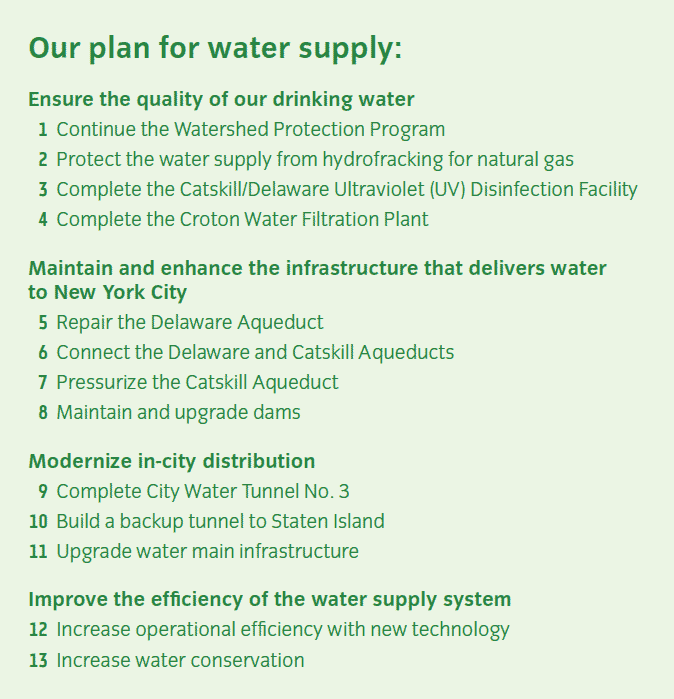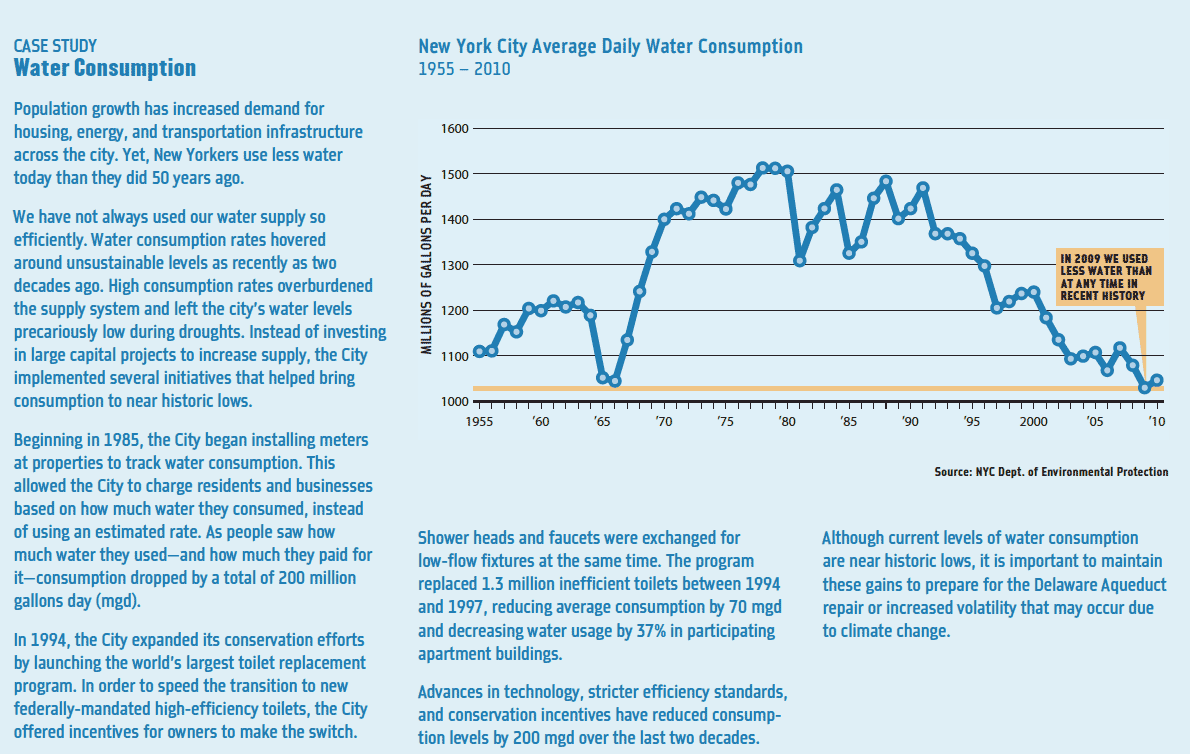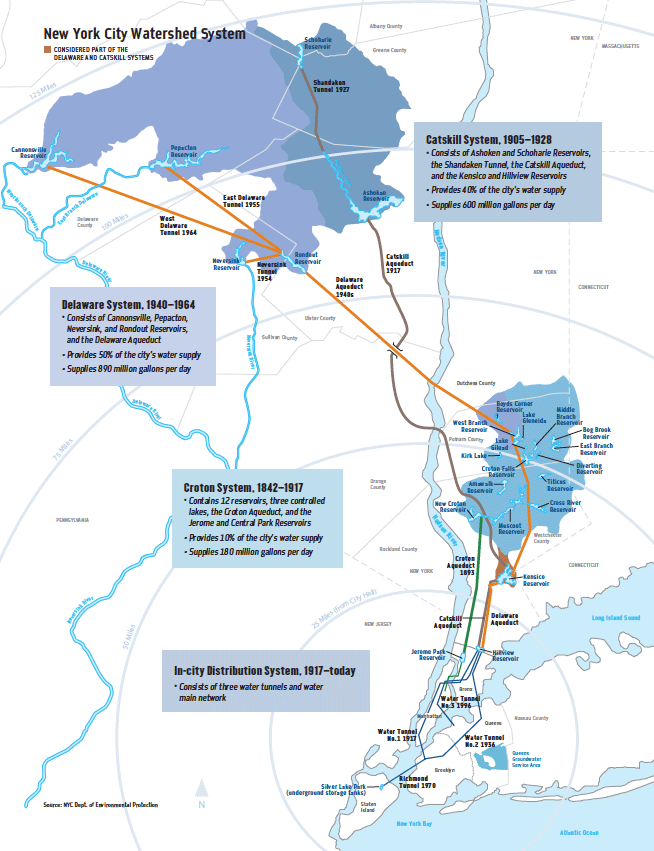
New York has one of the best water systems in the entire world. Our water is clear and clean, and is only one of five other cities in the United States that does not have to be filtered. All of our water comes from watersheds in Upstate New York, and this supply is abundant enough to meet our projected growth. However, there are many repairs and fixes that need to happen in order to preserve our great natural resource; the costs of inaction are too high.
 From the Catskill and Delaware Watershed and the Croton Aqueduct system, the water
From the Catskill and Delaware Watershed and the Croton Aqueduct system, the water
then goes through only three tunnels to distribute it to New York City. Tunnel No. 1 was completed in 1917, and has not been turned off since it started running. Tunnel No. 2
began service in 1936, covering Queens, the Bronx, and Staten Island. Construction on Tunnel No. 3 began in 1998. Stage 1 is completed, and it is now operati
ng to service theBronx and Upper Manhattan. Stage 2 will be in service for Manhattan by the end of 2013, and in service in Brooklyn and Queens when two connections are made so that Tunnel 3 is integrated seamlessly into the system. Tunnel No. 3 will provide necessary redundancy and allow the city to repair Tunnel No. 1 for the first time in history.
In the next 10 years, the City will invest nearly $7 billion to ensure the protection of our water supply from contamination, spurring economic activity for the city, acquiring watershed lands from willing sellers, and repairing key infrastructure for New York’s water supply.
Initiative 1: Continue the Watershed Protection Program
The Filtration Avoidance Determination (FAD) is testament to New York’s pristine water quality; it is a special waiver that determined New York does not need a filtration system. It is of utmost importance that we maintain this high quality because filtration plants are extremely costly. Therefore, the City is implementing a $462 million Watershed Protection Program that targets the greatest potential threats to our water supply. It combines protection, land acquisition, and environmentally sustainable economic development to maintain the quality of water supply.
Initiative 2: Protect the water supply from hydrofracking for natural gas
Underneath the Catskill and Delaware watersheds is part of the Marcellus Shale rock formation. This could potentially be the largest source of natural gas in the United States, and many companies and developers are seeking permission for the process of hydraulic fracturing (hydrofracking) to extract this gas. However, hydrofracking poses serious and costly threats to our water supply. It is an unrefined process that could permanently contaminate our entire water supply by leaking hazardous chemicals into the ground. The city will therefore completely oppose all drilling for natural gas within the watershed.
Initiative 3: Complete the Catskill/Delaware Ultraviolet (UV) Disinfection Facility
While we do not need an entire filtration plant, water still needs to be treated for bacteria, and this can be done with a UV Disinfection Facility. The world’s largest UV disinfection facility will be in service by May 2012.
Initiative 4: Complete the Croton Water Filtration Plan
The oldest and smallest of the City’s watersheds is the Croton system. It only supplies about 10% of the City’s water annually. Because it is the oldest in an area that has recently become highly developed (Westchester County) Croton water has seasonal variations in color, odor, and taste. The Croton Water Filtration Plant will be built underneath Mosholu Golf Course in Van Cortlandt Park and completed in 2013. It will feature the City’s largest green roof and provide up to 290 million gallons per day of clean water.
Initiative 5: Repair the Delaware Aqueduct
The Delaware Aqueduct is 85 miles long and supplies about half of NYC’s water. Since 1992, there have been continuous leaks at two different places in the aqueduct. While it has not been threatening, a $2.1 billion project will be undertaken to repair the leak. The City will ensure that when the Aqueduct needs to be shut off, there is enough City infrastructure in place to avoid any problems. The bypass tunnel that will be constructed is already underway, and will hopefully break ground by 2014.
Initiative 6: Connect the Delaware and Catskill Aqueducts
The City will connect the two largest watersheds so that cleaner water can be distributed from the Delaware into the Catskill Aqueduct. This will increase the system’s conveyance capacity and greatly improve water quality for New Yorkers. The interconnection is scheduled to begin in 2012.
Initiative 7: Pressurize the Catskill Aqueduct
Because of the Catskill/Delaware UV Disinfection Facility, the Catskill Aqueduct cannot sustain the current pressure. Once the Catskill Aqueduct is pressurized, it will increase the volume of the UV-treated water that can be delivered from the Catskill and Delaware watersheds.
Initiative 8: Maintain and upgrade dams
Part of the water supply system is the dams throughout the watersheds. However 29 of these dams are ‘high hazard’ because of a possibility of economic damage, environmental harm, and loss of human life if they were to fail. These require maintenance and repair since they were constructed almost a century ago. One dam in particular, the Gilboa Dam, will be upgraded to meet new safety standards and is scheduled to be completed in 2016.
Initiative 9: Complete City Water Tunnel No. 3
City Water Tunnel No. 3 is the most expensive capital project in the city’s history. As mentioned earlier, it is designed in stages, and the City is currently completing State 2—the Manhattan, Brooklyn, and Queens Leg. The completion of the City Water Tunnel No. 3 will enable the shut down of Tunnel No. 1 for inspection and repairs.
Initiative 10: Build a backup tunnel to Staten Island
Right now, the Richmond tunnel provides water to Staten Island. The Port Authority is deepening the harbor channel in which the tunnel is located, which means part of Staten Island’s water system needs to be replaced. A new tunnel will be completed by 2014.
Initiative 11: Upgrade water main infrastructure
After the water leaves the tunnels, it goes through 6,700 water mains to reach our homes. In order to support growth, these mains need to be repaired and maintained. This commitment will save ratepayers money by preventing costly water main breaks, and will also facilitate economic growth
Initiative 12: Increase operational efficiency with new technology
 Typically, water customers’ usage was manually measured every three months. With new technology now available, automatic meter reading (AMR) devices will be installed for all 835,000 customers by 2012. This is a giant step to conserving water and saving money. AMR devices provide real-time information and offers tools to reduce water use. The wireless equipment will give homeowners and small businesses more accurate and timely records of usage.
Typically, water customers’ usage was manually measured every three months. With new technology now available, automatic meter reading (AMR) devices will be installed for all 835,000 customers by 2012. This is a giant step to conserving water and saving money. AMR devices provide real-time information and offers tools to reduce water use. The wireless equipment will give homeowners and small businesses more accurate and timely records of usage.
Initiative 13: Increase water conservation
The City’s water usage was at an all-time low in 2011, and everyone should want to continue. The City will “lead by example” by increasing water conservation in government buildings. Even simple things like replacing old toilets can increase efficiency of a household.
We have reached a huge milestone in that New Yorkers can take our great water supply for granted. However, the City needs to guarantee this peace of mind for the future, and they will do that by upgrading the entire water system, building secondary tunnels for redundancy, protecting our watershed program, and monitoring our water with the newest technologies.
Read more:
An interview with Allan Frei of the CUNY Institute of Sustainable Cities, on New York’s water supply and the effects of climate change.
An infographic of New York’s water from 1800 to the present
